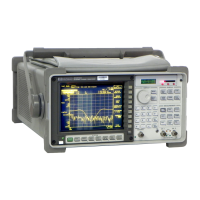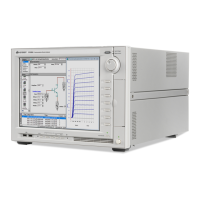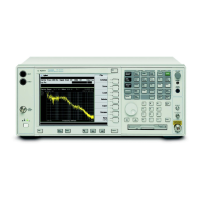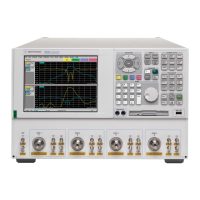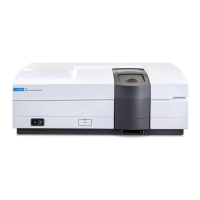CAT (Cable and Antenna Test) Mode 29
A 2-port Insertion Loss measurement is usually more accurate than a 1-port
Cable Loss measurement. However, to perform a 2-port Insertion Loss
measurement, both ends of the cable must be connected to the FieldFox, and the
FieldFox must have option 110 installed.
NOTE In high-loss conditions, a Cable Loss measurement becomes ‘noisy’ as the test
signal becomes indistinguishable in the FieldFox noise floor. This can occur
when measuring a very long cable and using relatively high measurement
frequencies. To help with this condition, use High Power (page 27), and
Averaging. (page 25).
How to make a 1-port Cable Loss Measurement
1. Press Preset then Preset.
2. Then More then Cable Loss (1-Port) .
3. Connect the cable to be tested.
4. Press Freq/Dist and enter Start and Stop frequency values of the
measurement.
5. Press Sweep 3 then Min Swp Time. Increase the Sweep Time until a stable
trace is visible on the screen. The amount of time that is required increases
with longer cable lengths. Learn more in the Supplemental Online Help:
www.agilent.com/find/fieldsfoxsupport
6. Remove the cable to be tested.
7. Press Cal 5 , then QuickCal or OSL.
8. Follow the prompts to perform calibration at the end of the jumper cable or
adapter. Learn more about Calibration on page 62.
9. Connect the cable to be tested.
NOTE Low-level standing waves (also also known as ‘ripple’) which may be visible in
reflection measurements, can hide the actual loss of the cable. Steps 10 through
13 can minimize the ripple. Perform the measurement with and without steps 10
through 13 and choose the method with the least amount of ripple.
10. Connect a LOAD at the end of the cable to be tested. This limits the
reflections to faults that are located in the cable under test.
11. Press Trace 6 then Data->Mem to store the trace into Memory.
12. Remove the LOAD and leave the end of the cable to be tested open.
13. Press Data Math then Data – Mem. The ripple in the measurement is
removed. These minor imperfections in the cable should not be considered in
the Cable Loss measurement.
14. Use Averaging to remove random noise from high-loss measurements. Press
BW 2 then Average.
The displayed trace shows the Cable Loss values in one direction through the
cable. A Return Loss measurement would show the loss for both down the cable
and back. Therefore, a Cable Loss measurement is the same as a Return Loss
measurement divided by 2.
The average Cable Loss across the specified frequency range is shown on the
screen below the graticules.
